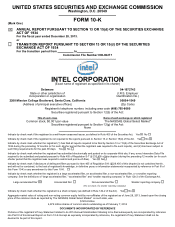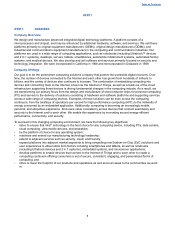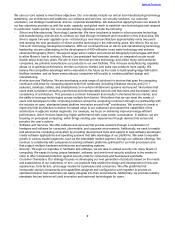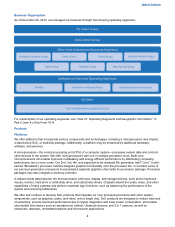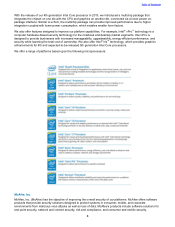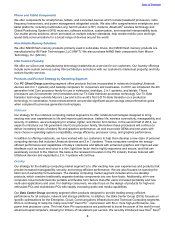Intel 2013 Annual Report Download - page 3
Download and view the complete annual report
Please find page 3 of the 2013 Intel annual report below. You can navigate through the pages in the report by either clicking on the pages listed below, or by using the keyword search tool below to find specific information within the annual report.
When I joined Intel in the early 1980’s, the company was respected
as an innovator whose founders had developed a strong and ethical
culture. As the decade progressed, Intel faced life-threatening
challenges, including a shortage of capital, operating losses and
erce competition. With tough-minded strategies and a determi-
nation to lead, the company adapted and built a vibrant future
with its core values intact. In technology, those who continue to
innovate create new opportunities. In the years since, I have seen this pattern of
regeneration often repeated. Today is another dening time for Intel, with big issues,
big possibilities, and a resilient culture.
Intel enters 2014 with leadership positions in important business segments, includ-
ing client computing, the data center, software, embedded systems, and NAND ash
memory. These businesses generated signicant nancial results in 2013, indicated
by high levels of prots, strong cash generation, and a healthy balance sheet. This
performance enabled Intel to deliver tangible value for stockholders, with $4.5 billion
paid in dividends and $2.1 billion spent to repurchase shares, bringing the cumulative
return to stockholders from dividends and repurchases to $125 billion.
While these accomplishments are notable, we need to do more.
It is imperative that we move swiftly to be more competitive in the market for
tablets. We must also protect and grow Intel’s core businesses while at the same time
pursuing new opportunities for growth. And we need to do more to provide the
integrated solutions customers increasingly seek.
Just as important, we must never forget what Moore’s Law tells us about the future:
computing devices will continually get smaller, lower cost, and higher performing, and
can also be more mobile. The tablet is an extension of our history, and we should have
recognized its potential sooner.
These considerations were top of mind in 2013 as the Board of Directors searched
for a new CEO. We wanted someone who would look at markets from a fresh perspec-
tive. We needed to be a leaner, more agile company attuned and reacting to the world
around it. And we needed a renewed focus on accountability and results—and to see
things as they are, not as we hope they would be. As always, we insisted on a person
who would put Intel’s success and stockholder return rst.
The challenges Intel faces are not new. Every year, nay-sayers predict that technology
has reached its limits and opportunities have diminished. Yet innovation never stops,
and technology continues to transform the way people go about their lives. I believe
the opportunities are as big and interesting as at any time in Intel’s history.
Before the microprocessor was invented, Intel founder Gordon Moore predicted that
integrated electronics would one day be available throughout all of society. Even
today Gordon is surprised to see this technology extend beyond anything he and his
colleagues imagined. You see technology everywhere, and silicon is the foundation.
As technology has become more pervasive, the responsibility for how it is made
and deployed has become more important. The people who work at Intel share the
public’s concerns about safety, security, privacy and sustainability. They are highly
motivated by the prospect that the products they make can be used to improve the
way people live. The question, “What is good for our business?” is answered with an eye
to what is good for the people who own our shares, the people who use our products,
and the people who work with us around the world.
Our clarity on this front has allowed the ve Intel CEOs with whom I’ve worked
to make more condent strategic decisions, because they know what matters to the
company. Nothing gives me greater condence in our future.
Letter From Your Chairman Financial Results
Andy D. Bryant, Chairman of the Board
Net Revenue
Dollars in billions
20
10
40
60
50
30
35.4 37.6 35.1
34.2
38.8 38.3
43.6
54.0 53.3 52.7
10090807060504 11 12 13
Diluted Earnings Per Share
Dollars
0.50
1.50
2.50
2.00
1.00
2.01
2.39
2.13
1.89
20102009 2011 2012 2013
0.77
0.20
0.60
1.00
0.80
Dividends Per Share Paid
Dollars
0.40
0.63
0.78
0.87 0.90
20102009 2011 2012 2013
0.56
20102009 2011 2012 2013
10
15
20
25
18.9
20.8
11.2
16.7
21.0
5
Cash from Operations
Dollars in billions




